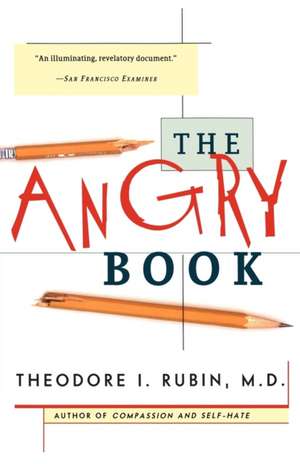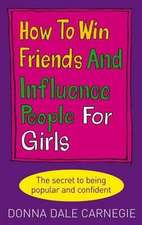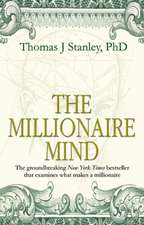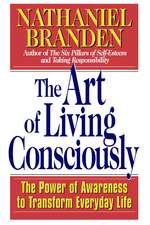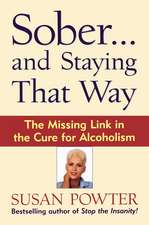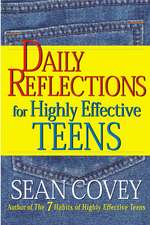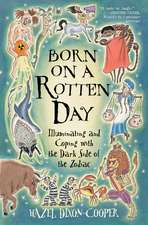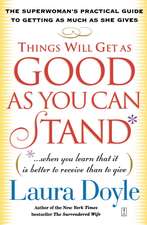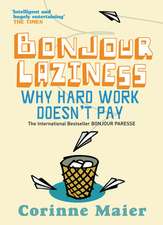The Angry Book
Autor Theodore I. Rubin M.D.en Limba Engleză Paperback – 27 apr 1998
When your love life is boring, maybe you don't fight enough? When sex leaves a person cold, is frozen anger the problem? If you work too much, eat too much, drink too much, is it because you are afraid to get mad? Did you ever think of your anger as something constructive?
When you lose your temper honestly, it can be good for you. In this perennially bestselling book, eminent psychiatrist and bestselling author Dr. Theodore Isaac Rubin shows how one of the most powerful human emotions can change your life. Suppressed or twisted anger can lead to anxiety, depression, insomnia, psychosomatic illness, alcoholism, frigidity, impotence, and downright misery. But understanding and releasing anger can lead to greater health, happiness, and emotional wholeness.
Let Dr. Rubin show you how to be what you are: a human being.
Preț: 94.49 lei
Nou
Puncte Express: 142
Preț estimativ în valută:
18.08€ • 18.76$ • 15.11£
18.08€ • 18.76$ • 15.11£
Carte disponibilă
Livrare economică 22 februarie-08 martie
Preluare comenzi: 021 569.72.76
Specificații
ISBN-13: 9780684842011
ISBN-10: 0684842017
Pagini: 216
Dimensiuni: 140 x 210 x 15 mm
Greutate: 0.3 kg
Editura: Touchstone Publishing
Colecția Touchstone
ISBN-10: 0684842017
Pagini: 216
Dimensiuni: 140 x 210 x 15 mm
Greutate: 0.3 kg
Editura: Touchstone Publishing
Colecția Touchstone
Notă biografică
Theodore Isaac Rubin, M.D., has served as president of the American Institute of Psychoanalysis and is the author of thirty books, including Compassion and Self-Hate, Lisa and David, Jordi, The Winner's Notebook, and Lisa and David Today. His books have been translated all over the world. He lives and practices psychiatry in New York City.
Cuprins
Introduction
1 BEGINNINGS
Even the Saints
Learning
Let Freedom Ring
Victims of Victims
Two Big Blocks
One Smaller Block
2 PERVERSIONS
Putting It Down
Putting It Off
Putting It On
Diluting It
Freezing It
3 TWISTING IT: THE ASSORTED POISONS
Anxiety
Depression
Guilt, Overeating, Self-Imposed Starvation
No Sleep and Sleep Sleep
Tomorrow and Tomorrow: Chronic Anticipation, Obsessive Ruminating, Peculiar Thoughts
Traps: Obsessions, Compulsions, Phobias
"No, No, No! A Thousand Times No!" -- Denial
Self-Sabotage
Sweet, Sweet, Sweet, and the Blood Pressure Goes Up, Up, Up
Talk, Talk, Talk, and No Talk
Let's Pretend: Imitations of Anger
Bullying
Supersweet Talk
Blatant Blasting
Overworking, Oversexing, Overexercising
Savers
Subtle Sabotage
"I'm with You"
Half-Poisons
"Don't Worry About Me"
Easy Talk
Auto Poison
Telling the Truth
Spread It Around
"Someone Dies"
Always Tired
Joking and Boring
Phony Peace
"I'm So Sick"
Forevermore
Poison Poisons: Drugs
Juice-Stewing
Slush-Fund Explosions
Short Circuits
4 UNTWISTING: PROPHYLAXIS AND ANTIDOTES
What Is It?
Black and White
Feel and Tell
Timing
Who
Anger Doesn't Kill
Drop Dead!
Forgive and Forget
With or Without Justice
Appropriate and Inappropriate
By the Sex
By Age
Warm, Cold, and In-Between
All or Nothing
The Big Blow-Up
To Be Angry and to Be Mad While the Storm Blows Angry Psychiatrists
5 TAKING A CHANCE ON ANGER
Questions
1 BEGINNINGS
Even the Saints
Learning
Let Freedom Ring
Victims of Victims
Two Big Blocks
One Smaller Block
2 PERVERSIONS
Putting It Down
Putting It Off
Putting It On
Diluting It
Freezing It
3 TWISTING IT: THE ASSORTED POISONS
Anxiety
Depression
Guilt, Overeating, Self-Imposed Starvation
No Sleep and Sleep Sleep
Tomorrow and Tomorrow: Chronic Anticipation, Obsessive Ruminating, Peculiar Thoughts
Traps: Obsessions, Compulsions, Phobias
"No, No, No! A Thousand Times No!" -- Denial
Self-Sabotage
Sweet, Sweet, Sweet, and the Blood Pressure Goes Up, Up, Up
Talk, Talk, Talk, and No Talk
Let's Pretend: Imitations of Anger
Bullying
Supersweet Talk
Blatant Blasting
Overworking, Oversexing, Overexercising
Savers
Subtle Sabotage
"I'm with You"
Half-Poisons
"Don't Worry About Me"
Easy Talk
Auto Poison
Telling the Truth
Spread It Around
"Someone Dies"
Always Tired
Joking and Boring
Phony Peace
"I'm So Sick"
Forevermore
Poison Poisons: Drugs
Juice-Stewing
Slush-Fund Explosions
Short Circuits
4 UNTWISTING: PROPHYLAXIS AND ANTIDOTES
What Is It?
Black and White
Feel and Tell
Timing
Who
Anger Doesn't Kill
Drop Dead!
Forgive and Forget
With or Without Justice
Appropriate and Inappropriate
By the Sex
By Age
Warm, Cold, and In-Between
All or Nothing
The Big Blow-Up
To Be Angry and to Be Mad While the Storm Blows Angry Psychiatrists
5 TAKING A CHANCE ON ANGER
Questions
Extras
Chapter 1
BEGINNINGS
In this section I want to describe some general considerations as well as some of the beginnings or origins of angry troubles.
Even the Saints
I assume the saints were human. I assume you are not a saint. All human beings get angry -- and I'm sure the saints did, too. Feeling angry is a universal human phenomenon. It is as basic as feeling hungry, lonely, loving, or tired. The capacity to feel angry and to respond in some way to that feeling is in us from birth. Have you ever seen a newborn baby cry and scream and get red with rage? He does so usually in response to some increase in bodily tension or discomfort or frustration -- the need for food or relief from the stick of a diaper pin, for example. Of course adults have their "tensions," and these are often born of very intricate, labyrinthlike dynamics. Sometimes the routes leading to feelings of anger are so convoluted and circuitous that it takes enormous skill to discern their original source, or fountainhead. But regardless of the reason for or the source of the anger or the relative ease or complexity in perceiving either the anger or its source -- everybody, but everybody, gets angry. As you will see later on, this may not always be apparent. But it is so! The only exceptions are those poor unfortunate people who suffer from one or another form of severe brain damage.
Learning
Those of us who are physiologically whole are born with the potential to feel and to express anger. But the things that make us angry and the ways we feel and the things we do when we are angry are not the same for all of us. The particular, individual ways in which we respond are learned. Generally, no one sits down and gives us lessons. We learn in more effective ways -- starting from the moment we are born.
Children are extremely perceptive and absorb what goes on around them long before they can talk or even comprehend language. They are like finely tuned receivers that pick up much more than is merely said. They are receptive and attuned to every mood, feeling, and change that goes on in people around them. They are particularly affected by the way their parents, sisters, and brothers feel and act. Many young children respond to a mother's "mood" long before she herself is consciously aware of its existence. This applies particularly to her approval and disapproval of how the child feels and acts.
Children do in fact "receive" and "record" what goes on around them, and they learn. They learn by doing over and over again -- by repetition -- and this doing is often initiated by imitation. They also learn by identification with a parent or relative. They learn by experimenting and testing, that is, by doing and then observing parental response to their actions. Of course all this applies to emotions and how the parents emote and respond to the child's feelings, especially the feeling -- and expression -- of anger.
Let Freedom Ring
Health is relative. There is no such thing as an absolute state of health or sickness. Everyone's physical, mental, and emotional condition is a combination of both. When health is preponderant, we are fortunate indeed -- as we are when the emotional climate in which we were brought up, in which we live, and which we provide for our children promotes health.
A healthy emotional climate is first one in which all the emotions -- especially anger -- are given ample play and freedom. This is an atmosphere in which there is no dearth of emotional output or exchange. There is no emotional vacuum, nor does one kind of emotional display exist to the exclusion of others. In this atmosphere emotional output is appropriate and consistent. In this atmosphere it is easy to know what people feel. It is especially easy to know when they are angry. This is so because feelings -- all kinds -- are accepted and the conveying of how one feels is accepted openly and freely without threat of dire reprisal. In this environment no feeling or its expression is labeled "good" or "bad." This climate is not designed for the manufacture of saints or sinners. It is meant for human beings who have ordinary emotional responses and the need to express them freely. In this climate a child readily picks up the prevalence of consistency, openness, and warmth regarding all feelings. In effect, this atmosphere says to the child: "It is all right to feel love, and it is all right to feel anger. It is all right to express love, and it is all right to express anger. Your feelings are welcome here, and we would like to know what they are. You are loved and accepted and safe with all your feelings. You needn't stifle any of them to please us.
Victims of Victims
So many of us are afraid to feel, afraid to express feelings, and afraid to have other people feel toward us. This is especially true when the feeling is anger. There are many of us in whom much emotional crippling has taken place. We can allow only so-called acceptable feelings to come through and then only with great care, constriction, and trepidation. For many of us the potential amplitude of feelings -- the vitality, depth, richness, and intensity -- is poor. For many of us our emotional displays are either very shallow (or utterly flat) or inappropriate or both. Those of us who suffer in this way are almost certainly former (and present) inhabitants of "sick" emotional climates. Blaming parents or relatives will not help. We are the victims of victims, and we, too, shall produce victims unless we choose to change ourselves and the immediate emotional climate through understanding.
What about a sick emotional climate?
This is an environment in which people often feel one way but act another way. When they are angry, they smile sweetly or freeze and do nothing at all. In any case, there is a paucity of straight, honest, simply and readily definable expressions of feelings. In this environment, there is sometimes a serious dearth of strong feelings, often to the point of emotional vacuum. Usually what look like appropriate, strong emotional responses are actually superficial, hysterical, manipulative outbursts turned on and off like summer showers. These serve to confuse further and to subvert real feelings. This is an environment in which hysteria may suddenly give way to inhibition and even to paralysis of emotional expression. In this atmosphere small issues will evoke large displays and large issues will evoke nothing. This atmosphere will be marked by many intricate inconsistencies that the child can't possibly understand. This will be particularly so with anger and may result in an avoidance of anger and subsequent crippling in this very important emotional area. In effect, the victim will be told the following: "It is all right for me to get angry in this circumstance but not you." "Sometimes it is all right for you to get angry, but sometimes you can't, even though the circumstances are identical. It all depends on my mood -- which there is no way of knowing." "Why can't you be like me -- I never get angry, but when I do, I don't show it. All I do is get cold and sullen and withdraw my attention and affection from you." "If you get angry, I'll know you don't love me." "Nice boys and girls don't get angry -- especially at adults." "If you must get angry, at least be polite." "If you get angry, you will not be liked." "If you continue to get angry, you will surely get into great trouble." "Civilized people don't get angry, but if you get angry I'll have to tell Daddy, and he will get angry and will have to punish you when he gets home."
Parents in this environment will very often produce what is known as a double-bind situation which goes like this: "Don't hold it in -- I can't stand when you do -- let it out! But when you let it out, I will hit you for being disrespectful." This damned-if-you-do, damned-if-you-don't approach promotes severe conflict, much anxiety, great angry problems, and emotional paralysis.
Two Big Blocks
These are big destructive blocks to feeling and showing anger. Let's look at them, one at a time.
I call the first one "the secret pact" or "the be a nice guy -- don't make waves" syndrome. The terms of the secret pact are very simple: "I won't get angry, and therefore I will be sure that you don't get angry." The pact is secret because the other party, especially if he's a person who feels free to get angry, doesn't know it exists. In any case, "don't-make-wavers" are generally people who predicate their whole lives and personalities on being "nice guys" and on being universally liked. Of course they feel that anger, especially if it shows, will destroy the image they live by. These people feel that any show of anger -- even minor irritation -- will alienate the other fellow. This is seen as an immediate threat to one's "nice guy" status and involves a potential loss of love. Since being universally loved is seen as the only way to be safe in this world, anger -- especially anger that causes retaliation by the other fellow -- is of course felt as a terrible threat. The "nice guy" is therefore forced into constantly playing a role. The price he pays for this role-playing is enormous. He can never be himself, and he expends enormous energy in attempting to fool himself and other people. Sadly none of this works. He seduces no one into liking him. Those that like him will like him in any case, and those that don't, won't. Even more sadly, blocking off anger ultimately destroys the very thing the "nice guy" wants -- namely love. But more about this and other destructive effects later on. Suffice it here to say that the need to be universally liked, to ruffle no one's feelings, serves as an enormous block to the natural free feel and flow of anger.
The other big block, ultimately just as destructive, is the mind-your-own-business syndrome. The "emotional isolationist" honestly believes that if he doesn't get involved with other people, he won't get hurt. Of course anger, in any of its manifestations, is seen as a threat to his noninvolvement status. He must not get angry, let alone show it, because this would indicate caring enough to get angry. He sees this kind of caring as leading to involvement, emotional snares, and all kinds of people traps. He would rather "cool it and keep safe." Of course the ostrich phenomenon doesn't work. Man is a community creature and cannot function in isolation. However ingeniously the emotional isolationist plots his course, emotional investment in other people and their investment in him will be inevitable. The only effect "cooling it" will have is to deprive him of the enormous benefits healthy, open social intercourse brings. "Cooling" anger will also contribute to the many poisons I will describe later on.
I want to close this chapter by saying that blocking anger makes us even greater "don't-make-wavers" and emotional isolationists, thus completing a very destructive vicious cycle.
One Smaller Block
The effects of this block are exactly the same in destructive value as those of the two big blocks. I call this one a smaller block only because people suffering from it have slightly less difficulty getting angry than those with the big blocks.
This "smaller block" is the need for control or mastery. People who have this need feel that angry feelings or a show of anger may be evidence of loss of control. Since they predicate their lives and well-being on total control of themselves, others, and the total environment, potential loss of control is invariably felt as a great threat. Unlike the previous two blocks (which operate mainly in people whom Horney calls self-effacing or compliant and detached or resigned -- the "don't-make-wavers" and the noninvolvement specialists), this smaller block occurs mostly in expansive people (Horney's term) and does allow some feel and show of anger. However, this is seldom a healthy, warm anger, which I will describe later on. Expansive anger is usually used in the service of sadistic manipulation or outright bullying in controlling people. It is often dished out under the guise of benevolence, but it always involves domineering despotism. It is also used in conjunction with vindictiveness, sometimes providing the sick energy necessary for vindictiveness to take place. This sick and synthetic anger is stunted and distorted because of the victim's inordinate need to be admired, if not worshiped (as differentiated from being liked). Since real undiluted anger may result in a diminishment of admiration and is seen as a loss of control of one's self and others, it is blocked and viewed with fear and trepidation.
Based on an individual's character structure, one of the three blocks will be used predominantly. However, use of all the blocks may be evident in the same person.
Copyright © 1969 by Dr. Theodore Isaac Rubin
Copyright renewed © 1997 by Theodore Isaac Rubin
BEGINNINGS
In this section I want to describe some general considerations as well as some of the beginnings or origins of angry troubles.
Even the Saints
I assume the saints were human. I assume you are not a saint. All human beings get angry -- and I'm sure the saints did, too. Feeling angry is a universal human phenomenon. It is as basic as feeling hungry, lonely, loving, or tired. The capacity to feel angry and to respond in some way to that feeling is in us from birth. Have you ever seen a newborn baby cry and scream and get red with rage? He does so usually in response to some increase in bodily tension or discomfort or frustration -- the need for food or relief from the stick of a diaper pin, for example. Of course adults have their "tensions," and these are often born of very intricate, labyrinthlike dynamics. Sometimes the routes leading to feelings of anger are so convoluted and circuitous that it takes enormous skill to discern their original source, or fountainhead. But regardless of the reason for or the source of the anger or the relative ease or complexity in perceiving either the anger or its source -- everybody, but everybody, gets angry. As you will see later on, this may not always be apparent. But it is so! The only exceptions are those poor unfortunate people who suffer from one or another form of severe brain damage.
Learning
Those of us who are physiologically whole are born with the potential to feel and to express anger. But the things that make us angry and the ways we feel and the things we do when we are angry are not the same for all of us. The particular, individual ways in which we respond are learned. Generally, no one sits down and gives us lessons. We learn in more effective ways -- starting from the moment we are born.
Children are extremely perceptive and absorb what goes on around them long before they can talk or even comprehend language. They are like finely tuned receivers that pick up much more than is merely said. They are receptive and attuned to every mood, feeling, and change that goes on in people around them. They are particularly affected by the way their parents, sisters, and brothers feel and act. Many young children respond to a mother's "mood" long before she herself is consciously aware of its existence. This applies particularly to her approval and disapproval of how the child feels and acts.
Children do in fact "receive" and "record" what goes on around them, and they learn. They learn by doing over and over again -- by repetition -- and this doing is often initiated by imitation. They also learn by identification with a parent or relative. They learn by experimenting and testing, that is, by doing and then observing parental response to their actions. Of course all this applies to emotions and how the parents emote and respond to the child's feelings, especially the feeling -- and expression -- of anger.
Let Freedom Ring
Health is relative. There is no such thing as an absolute state of health or sickness. Everyone's physical, mental, and emotional condition is a combination of both. When health is preponderant, we are fortunate indeed -- as we are when the emotional climate in which we were brought up, in which we live, and which we provide for our children promotes health.
A healthy emotional climate is first one in which all the emotions -- especially anger -- are given ample play and freedom. This is an atmosphere in which there is no dearth of emotional output or exchange. There is no emotional vacuum, nor does one kind of emotional display exist to the exclusion of others. In this atmosphere emotional output is appropriate and consistent. In this atmosphere it is easy to know what people feel. It is especially easy to know when they are angry. This is so because feelings -- all kinds -- are accepted and the conveying of how one feels is accepted openly and freely without threat of dire reprisal. In this environment no feeling or its expression is labeled "good" or "bad." This climate is not designed for the manufacture of saints or sinners. It is meant for human beings who have ordinary emotional responses and the need to express them freely. In this climate a child readily picks up the prevalence of consistency, openness, and warmth regarding all feelings. In effect, this atmosphere says to the child: "It is all right to feel love, and it is all right to feel anger. It is all right to express love, and it is all right to express anger. Your feelings are welcome here, and we would like to know what they are. You are loved and accepted and safe with all your feelings. You needn't stifle any of them to please us.
Victims of Victims
So many of us are afraid to feel, afraid to express feelings, and afraid to have other people feel toward us. This is especially true when the feeling is anger. There are many of us in whom much emotional crippling has taken place. We can allow only so-called acceptable feelings to come through and then only with great care, constriction, and trepidation. For many of us the potential amplitude of feelings -- the vitality, depth, richness, and intensity -- is poor. For many of us our emotional displays are either very shallow (or utterly flat) or inappropriate or both. Those of us who suffer in this way are almost certainly former (and present) inhabitants of "sick" emotional climates. Blaming parents or relatives will not help. We are the victims of victims, and we, too, shall produce victims unless we choose to change ourselves and the immediate emotional climate through understanding.
What about a sick emotional climate?
This is an environment in which people often feel one way but act another way. When they are angry, they smile sweetly or freeze and do nothing at all. In any case, there is a paucity of straight, honest, simply and readily definable expressions of feelings. In this environment, there is sometimes a serious dearth of strong feelings, often to the point of emotional vacuum. Usually what look like appropriate, strong emotional responses are actually superficial, hysterical, manipulative outbursts turned on and off like summer showers. These serve to confuse further and to subvert real feelings. This is an environment in which hysteria may suddenly give way to inhibition and even to paralysis of emotional expression. In this atmosphere small issues will evoke large displays and large issues will evoke nothing. This atmosphere will be marked by many intricate inconsistencies that the child can't possibly understand. This will be particularly so with anger and may result in an avoidance of anger and subsequent crippling in this very important emotional area. In effect, the victim will be told the following: "It is all right for me to get angry in this circumstance but not you." "Sometimes it is all right for you to get angry, but sometimes you can't, even though the circumstances are identical. It all depends on my mood -- which there is no way of knowing." "Why can't you be like me -- I never get angry, but when I do, I don't show it. All I do is get cold and sullen and withdraw my attention and affection from you." "If you get angry, I'll know you don't love me." "Nice boys and girls don't get angry -- especially at adults." "If you must get angry, at least be polite." "If you get angry, you will not be liked." "If you continue to get angry, you will surely get into great trouble." "Civilized people don't get angry, but if you get angry I'll have to tell Daddy, and he will get angry and will have to punish you when he gets home."
Parents in this environment will very often produce what is known as a double-bind situation which goes like this: "Don't hold it in -- I can't stand when you do -- let it out! But when you let it out, I will hit you for being disrespectful." This damned-if-you-do, damned-if-you-don't approach promotes severe conflict, much anxiety, great angry problems, and emotional paralysis.
Two Big Blocks
These are big destructive blocks to feeling and showing anger. Let's look at them, one at a time.
I call the first one "the secret pact" or "the be a nice guy -- don't make waves" syndrome. The terms of the secret pact are very simple: "I won't get angry, and therefore I will be sure that you don't get angry." The pact is secret because the other party, especially if he's a person who feels free to get angry, doesn't know it exists. In any case, "don't-make-wavers" are generally people who predicate their whole lives and personalities on being "nice guys" and on being universally liked. Of course they feel that anger, especially if it shows, will destroy the image they live by. These people feel that any show of anger -- even minor irritation -- will alienate the other fellow. This is seen as an immediate threat to one's "nice guy" status and involves a potential loss of love. Since being universally loved is seen as the only way to be safe in this world, anger -- especially anger that causes retaliation by the other fellow -- is of course felt as a terrible threat. The "nice guy" is therefore forced into constantly playing a role. The price he pays for this role-playing is enormous. He can never be himself, and he expends enormous energy in attempting to fool himself and other people. Sadly none of this works. He seduces no one into liking him. Those that like him will like him in any case, and those that don't, won't. Even more sadly, blocking off anger ultimately destroys the very thing the "nice guy" wants -- namely love. But more about this and other destructive effects later on. Suffice it here to say that the need to be universally liked, to ruffle no one's feelings, serves as an enormous block to the natural free feel and flow of anger.
The other big block, ultimately just as destructive, is the mind-your-own-business syndrome. The "emotional isolationist" honestly believes that if he doesn't get involved with other people, he won't get hurt. Of course anger, in any of its manifestations, is seen as a threat to his noninvolvement status. He must not get angry, let alone show it, because this would indicate caring enough to get angry. He sees this kind of caring as leading to involvement, emotional snares, and all kinds of people traps. He would rather "cool it and keep safe." Of course the ostrich phenomenon doesn't work. Man is a community creature and cannot function in isolation. However ingeniously the emotional isolationist plots his course, emotional investment in other people and their investment in him will be inevitable. The only effect "cooling it" will have is to deprive him of the enormous benefits healthy, open social intercourse brings. "Cooling" anger will also contribute to the many poisons I will describe later on.
I want to close this chapter by saying that blocking anger makes us even greater "don't-make-wavers" and emotional isolationists, thus completing a very destructive vicious cycle.
One Smaller Block
The effects of this block are exactly the same in destructive value as those of the two big blocks. I call this one a smaller block only because people suffering from it have slightly less difficulty getting angry than those with the big blocks.
This "smaller block" is the need for control or mastery. People who have this need feel that angry feelings or a show of anger may be evidence of loss of control. Since they predicate their lives and well-being on total control of themselves, others, and the total environment, potential loss of control is invariably felt as a great threat. Unlike the previous two blocks (which operate mainly in people whom Horney calls self-effacing or compliant and detached or resigned -- the "don't-make-wavers" and the noninvolvement specialists), this smaller block occurs mostly in expansive people (Horney's term) and does allow some feel and show of anger. However, this is seldom a healthy, warm anger, which I will describe later on. Expansive anger is usually used in the service of sadistic manipulation or outright bullying in controlling people. It is often dished out under the guise of benevolence, but it always involves domineering despotism. It is also used in conjunction with vindictiveness, sometimes providing the sick energy necessary for vindictiveness to take place. This sick and synthetic anger is stunted and distorted because of the victim's inordinate need to be admired, if not worshiped (as differentiated from being liked). Since real undiluted anger may result in a diminishment of admiration and is seen as a loss of control of one's self and others, it is blocked and viewed with fear and trepidation.
Based on an individual's character structure, one of the three blocks will be used predominantly. However, use of all the blocks may be evident in the same person.
Copyright © 1969 by Dr. Theodore Isaac Rubin
Copyright renewed © 1997 by Theodore Isaac Rubin
Recenzii
San Francisco Examiner An illuminating, revelatory document.
S. Dave Babbitt Speaking of Books If his observations are correct, the screamers among us are doing all right. But watch out for those cold and quiet cats.
S. Dave Babbitt Speaking of Books If his observations are correct, the screamers among us are doing all right. But watch out for those cold and quiet cats.
